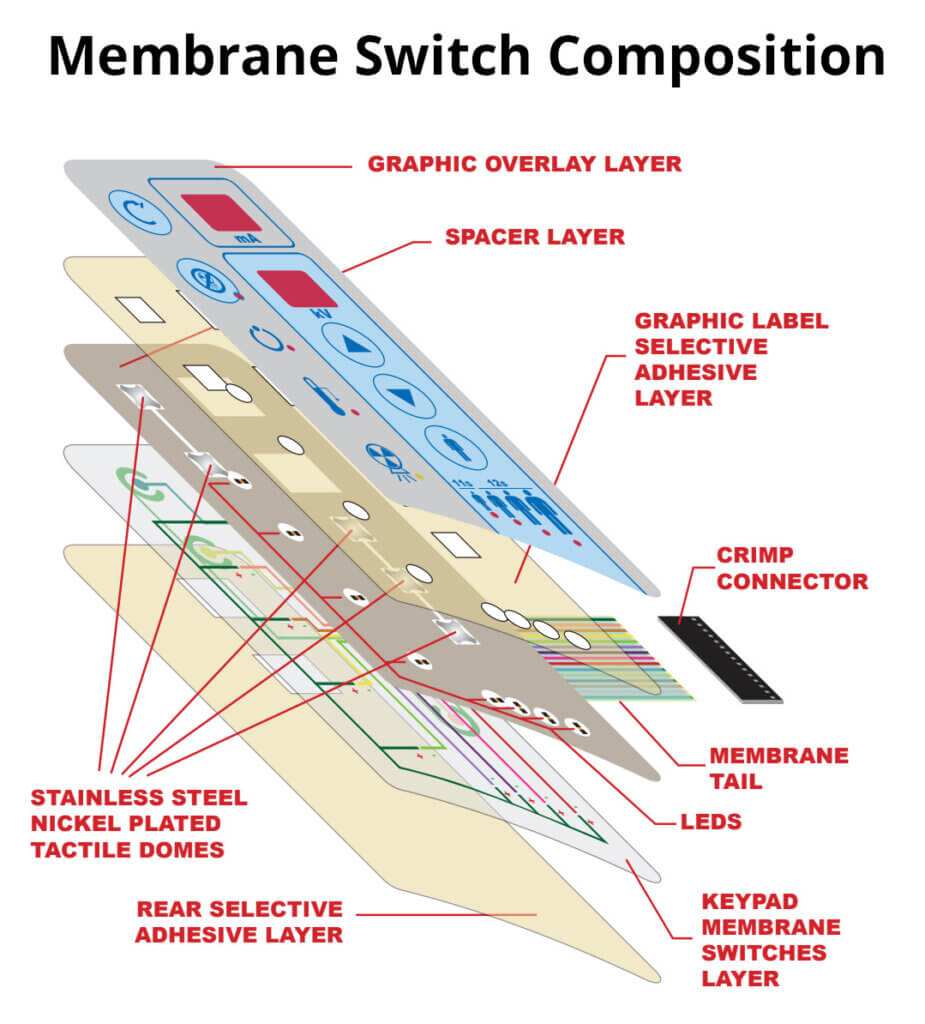Top Features to Look for in a High-Quality Membrane Switch
Understanding Membrane Layer Switches Over: The Secret to Reputable and resilient Controls

What Are Membrane Switches?
Membrane buttons are an innovative option in the realm of user interface technology, combining functionality and layout flawlessly. These tools function as a user interface in between customers and electronic systems, incorporating numerous elements right into a portable style. Normally created from adaptable, slim layers of materials, membrane switches are made to reply to touch, allowing customers to engage with equipment and electronic gadgets successfully.
The main components of a membrane layer button consist of a published circuit layer, graphic overlay, and a spacer layer that avoids unintentional activation. The visuals overlay can be customized to mirror brand identification or user preferences, improving aesthetics while guaranteeing functionality. Membrane switches are commonly utilized in various applications, including clinical tools, consumer electronic devices, and commercial devices, owing to their toughness and resistance to ecological variables such as dampness and dust.
Among the essential advantages of membrane switches is their ability to endure damage, making them excellent for high-traffic atmospheres. In addition, they are light-weight and need marginal room, allowing for ingenious layouts in item advancement. On the whole, membrane layer switches over stand for a practical and efficient selection for contemporary electronic interfaces, weding modern technology with user-centric layout principles.
Just How Membrane Switches Job
The procedure of membrane layer changes hinges on a straightforward yet reliable mechanism that converts user input right into digital signals. When a user presses the button, the top layer deforms, enabling a conductive component in the circuit layer to make call with a matching conductive pad on the bottom of the visuals overlay.
The design of membrane buttons can differ, but they typically incorporate domes or tactile elements to offer feedback to the individual, improving the general experience - membrane switch. The materials utilized in membrane layer switches, such as polyester or polycarbonate, add to their longevity and resistance to ecological elements, including wetness and dust. In addition, the published circuits are typically enveloped, which protects them from damage in time.
Advantages of Membrane Buttons

Furthermore, membrane switches are recognized for their longevity. Constructed from durable materials, they are resistant to dust, wetness, and physical wear, which considerably extends their lifespan compared to typical mechanical switches. This resilience makes them specifically suitable for high-traffic environments and applications requiring longevity.
An additional considerable advantage is the simplicity of cleaning and maintenance. The pop over to these guys smooth surface area of membrane switches over reduces dirt buildup and is often unsusceptible spills, making them excellent for settings that require regular sanitization.
Moreover, membrane buttons offer a structured account, leading to a thinner layout that can be incorporated right into numerous devices without including mass. This function not just improves the aesthetic allure but also adds to a more ergonomic product layout.
Applications of Membrane Layer Buttons
Flexible and user-friendly, membrane layer switches find applications across a broad range of industries, including clinical devices, customer electronics, and commercial tools. In the medical area, these buttons are important to gadgets such as diagnostic equipment, patient tracking systems, and mixture pumps, where reliability and ease of cleansing are important. Their capacity to stand up to severe environments and keep capability makes them excellent for such applications.

In consumer electronic devices, membrane buttons are made use of in products like microwaves, washing devices, and remotes - membrane switch. Their sleek layout permits intuitive user interfaces, improving the general user experience while offering longevity and resistance to tear and put on
Commercial tools also gains from membrane buttons, specifically in control panels for machinery and automation systems. These switches supply protection versus dust and moisture, ensuring constant efficiency in tough settings. Additionally, their adjustable features permit manufacturers to tailor them to specific functional needs, enhancing efficiency and capability.
Selecting the Right Membrane Layer Change
When selecting a membrane layer button, it is vital to consider numerous elements that influence efficiency and suitability for specific applications. The main considerations consist of ecological conditions, tactile comments, sturdiness, and layout requirements.
First, assess the operating environment; buttons subjected to dampness, chemicals, or extreme temperature levels require details products to make sure long life and performance. Next off, assess the need for responsive go to website responses. Relying on user interaction, some applications may take advantage of a responsive action to verify activation, while others might prefer a non-tactile design for visual factors.
Toughness is an additional important aspect; membrane buttons need to be created to stand up to constant usage, influences, and abrasion. Ensure the selected button can endure the expected lifecycle, especially in high-usage scenarios.

Final Thought
In final thought, membrane changes offer as important parts in the design of resilient and reliable control systems throughout various sectors. The convenience of membrane layer switches allows for tailored remedies that fulfill specific functional demands, enhancing their relevance in contemporary site link innovation.
Membrane layer switches over stand for a crucial facet of contemporary interface design, mixing performance with strength in different applications.Membrane layer buttons are a sophisticated option in the world of individual interface innovation, integrating functionality and design flawlessly. Generally built from flexible, slim layers of materials, membrane switches are designed to react to touch, allowing users to engage with equipment and digital tools properly.
The style of membrane layer switches can vary, yet they commonly integrate domes or responsive elements to provide feedback to the individual, boosting the general experience.In final thought, membrane layer changes offer as important elements in the design of trustworthy and sturdy control systems across various sectors.